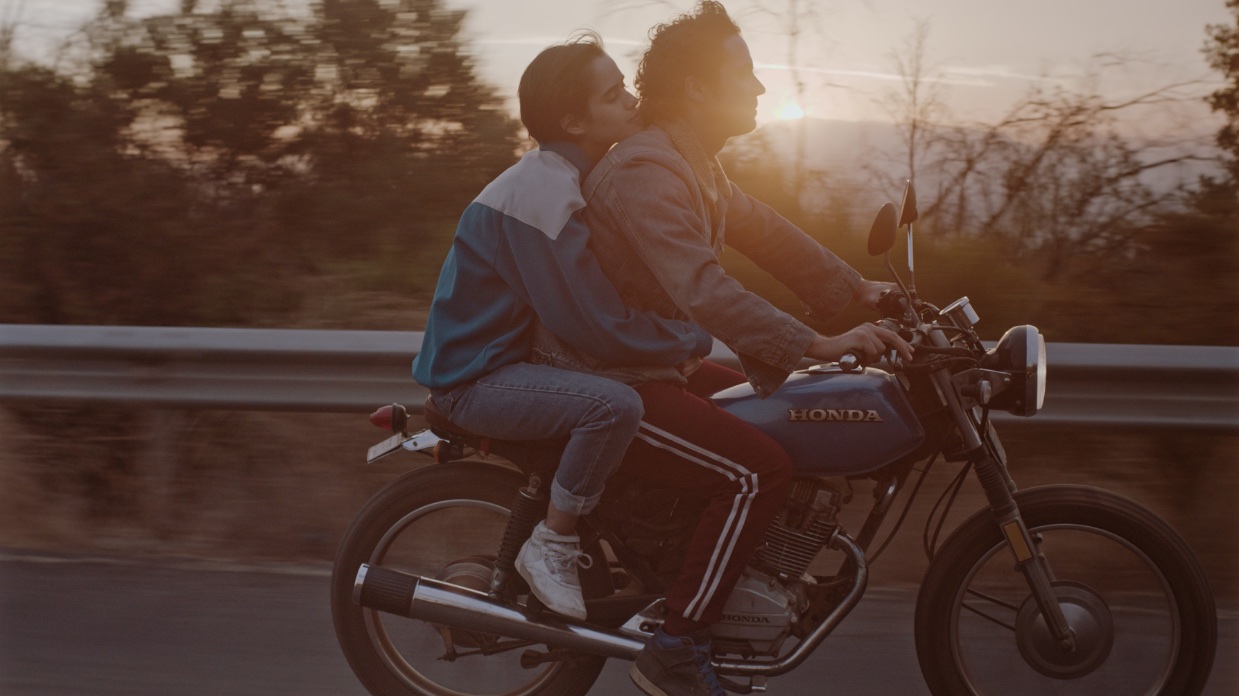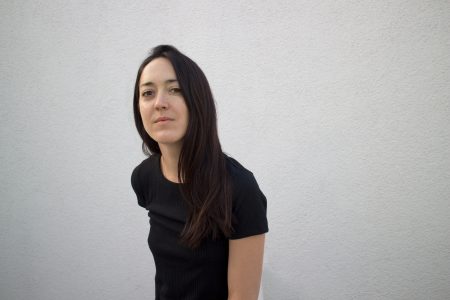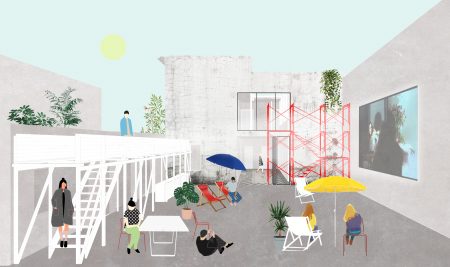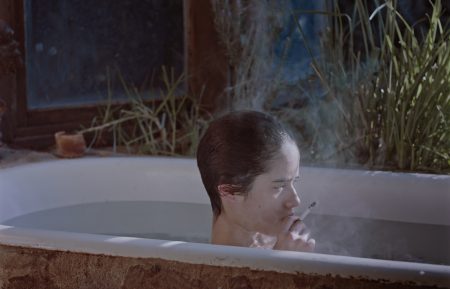 Back to selection
Back to selection
“I Still Have the Illusion of Community”: Director Dominga Sotomayor on Her Second Feature, Too Late to Die Young, and the New Santiago Coworking Space CCC
 Too Late to Die Young
Too Late to Die Young The possibility and impossibility of community lies at the heart of Chilean Dominga Sotomayor’s second feature film, Too Late To Die Young, which follows a group of young people living in a community being formed by their parents on the outskirts of Santiago. While the country is undergoing its own transition to democracy from the 17-year dictatorship of General Pinochet and their parents try to build a society that reflects their own values, the teenagers, particularly Sofía (Demian Hernández), seek to find their place in the world, all the while watched by a younger generation of children looking to emulate them. It is a true ensemble film, a collective portrait of a society in transition, and a vision of Chile likely to be new to most international viewers.
The film brought Sotomayor the Best Director Award at last year’s Locarno Film Festival, making her the first woman in the festival’s history to win the award. She’d previously become known internationally when her first feature, Thursday till Sunday, won a Tiger Award at the Rotterdam Film Festival in 2012.
What is less known abroad is that in her early 30s, Sotomayor is also a prolific producer committed to developing ways for filmmakers to support each other’s work. Together with editor Catalina Marín and director and producer Omar Zuñiga (winner of the Berlin Film Festival’s Teddy Award for his short San Cristóbal) she has operated a cooperative production company for over a decade, and she along with Marín and two other partners founded the Center for Cinema and Creation (CCC), an ambitious work space and community space for filmmakers currently under construction that will include a screening room and classroom.
We spoke over coffee in Providencia, the neighborhood in Santiago where Sotomayor lives, not far from the construction site of the CCC. Too Late to Die Young opens today in New York at Film at Lincoln Center.

Filmmaker: I’m always very interested when filmmakers create their own structures for working.
Sotomayor: I’m always trying to question the way things are usually made. The way you produce is a political and aesthetic choice. Each film has a nature, and it’s not the same film if you make it with five people or with 30, whatever amount of money, with co-productions or not. We have been doing films for a long time at Cinestación, and we try to be very involved in how these decisions change something creatively.
Omar, Catalina and I were classmates in the first generation of cinema students at Universidad Católica.
Filmmaker: Because the school was shut down during the dictatorship?
Sotomayor: Yes. They reopened it with our generation, so it was a special generation. I don’t know if the school was very good, but it had the energy of the reopening of the school. We created the company when we made our shorts in order to have the freedom to not depend on another production company, and then we started naturally collaborating with friends from Latin America, producing films by people we admire, filmmakers we met in festivals.
Filmmaker: And you all switch roles depending on the project? For example, Omar produced Too Late To Die Young and now you are producing his film Los Fuertes?
Sotomayor: I like this idea of a collective. For instance, we were having Friday lunches in the office where you could talk about a personal project you have. Five years ago, Karin Cuyul was working with us an assistant producer and she told us her idea for a documentary about her childhood. It became a project called Story of My Name, we were able to finance it, and it just premiered at Rotterdam and won an Honorable Mention. It is a beautiful documentary, and it was nice that she was an assistant producer and became a director.
Filmmaker: And CCC is an expansion of this idea?
Sotomayor: There is a big contradiction between how Chilean cinema is seen abroad and the space it has at home. Chilean film is in a very good moment and we have funding for production, but we don’t have support for distribution, and we don’t have spaces to show Chilean films at home.

Filmmaker: People here really don’t see the Chilean films.
Sotomayor: No! So with this in mind and also the idea of how Cinestación works, we wanted to translate something in that spirit to CCC. We found an old building in the center of Santiago, formed a nonprofit organization and got a landmark fund for renovation and restoration. The construction started in November. There will be offices where people can work, a space for seminars and workshops, a cinema with 30 seats, a gallery where we can make shows and art events and a big garden with a cafe and bar where we’ll make outdoor screenings. There is a nothing like this in Santiago, and people from the industry have been very supportive. Alfredo Castro, the actor, just visited and wants to make classes, and Sebastian Lelio and Pablo Larraín. They travel to tons of festivals and then when they return to Chile they don’t have a place.
It’s a project that’s been a dream for a long time. I hope it will be a contribution to Chilean cinema.
Filmmaker: You’ll create the next generation of filmmakers.
Sotomayor: Yes, and also something good for the neighborhood.
Filmmaker: And in the meantime you’re travelling the world with Too Late to Die Young, because the film is really showing everywhere.
Sotomayor: It’s been a big surprise what has happened with Too Late to Die Young. I thought it is a very particular film, from Chile which is already a particular country but even in a very particular place in Santiago. So, I’m happy that people relate to the film.
Filmmaker: I saw the film last year, and then again a few nights ago with my wife, Rocío, who grew up at almost the same time as you in a similar community on the edge of Santiago. As she was watching she said it was exactly like her childhood down to the smallest details. It’s what I call carbon dating. You can look at the film and say it could have only taken place in this certain time and place, these two years maybe, in one or two communities. But her question as she watched it was is why was it important to you to recreate this time rather than tell the story of Sofia in the present?
Sotomayor: It’s interesting because there is a contradiction. It is a film that comes from a specific summer when I came to live in a place similar to the community portrayed. It was a summer where we were waiting for democracy, because Pinochet had been kicked out in December and the first democractic president would start in March, so it was a transition itself. I was four or five when we moved there, and although my parents never related our move to the arrival of democracy, for me it was pretty obvious that there was a need to move at that time.
On the other hand, I like when films work with what is timeless and spaceless. Even though my motivation comes from that time and it is full of the images of the period, I decided to keep out anything literal, like the mention of Pinochet. For me it was more important to see the emotional impact of this period on these characters in order to try to depict a collective state of mind. I’m not interested in big stories, I’m interested in what’s in-between. In these intersections I find the possibility to document something deeper that is not in books, not in history. So even though it is not a film about the arrival of democracy, it’s a film about transitions, about illusions.
Filmmaker: Illusions in terms of the community? I was very interested in your depiction of community as impossible. I mean there is something to it, but you don’t look at it in a utopian way. People are fighting with each other, sleeping with each other’s partners —
Sotomayor: It is an illusion of the whole group that it is possible to make another society. We will replicate the same thing — we are humans. It is like a self-exile where you are confronted by yourself. And if there is a lack of water, you will steal the water from the neighbor.
It was a very particular way of life that we couldn’t describe at the time. I knew it was a community, but what was the goal? For me it was difficult to explain while I was little. And I thought I can’t make a film that is conventional in its form if I am trying to capture something that is close to life or organic. I wanted the film to be as close as possible to life as I lived it there.
Filmmaker: It must have been difficult to understand as a script as well, because what’s very central to the experience of watching it is seeing the delicate relationships between the three worlds inside the community: the children, the teenagers and the adults. If I was reading the script, I probably wouldn’t see how they impact and form each other, it might just seem like a lot of characters.
Sotomayor: It was very difficult to finance because people would say it is very dispersed. There are too many characters to follow. And it was difficult to explain it as a project. “Why isn’t it focused on one character?” “Because I wanted to make it like this.” It was a script that I did over a long period. For example I wrote one month, then I left it for a year, then I came back. It was like a slow cooker, crossing many periods of my life.
Filmmaker: Was the visual sensibility part of the screenplay, or did it come later?
Sotomayor: I usually start by describing images in the script, even layers like “in the first layer you can see this, in the background this…” That is already in the script. So one of the first images — because I start working with images rather than narration — was this house without walls, where the idea of interior and exterior are the same.

Filmmaker: That’s a great house.
Sotomayor: What was important for me was erasing the hierarchy between the humans and animals and nature. I wanted to make a film where everything is on the same level. One my rules with Inti [Briones, DoP] was that is a place “with” people and not people arriving at a place. It’s the same way of approaching people, houses, nature or animals.
I believe in dispersions and digressions. In my life, I’ve always been doing many things. I will be part of a theater piece this Fall, and I made a couple of exhibitions related to this film before we filmed. I found some VHS tapes of the real forest fire that happened in 1991 in the community. I was five at the time. I never saw the fire because I was in a water tank with a friend, thinking that I would survive there. I heard all the screams, I knew it was a big fire, but I never saw the fire itself. So it was all in my imagination. But a couple years ago I found VHS tapes belonging to a neighbor who had been filming the day of the fire. There was something nice that I talked about with Inti about the importance of what is off-screen. It is related to the VHS because the neighbor was filming without looking through the camera and I love the framing that happened. It’s really random. So I was trying to get some of this randomness — to look, to frame what isn’t supposed to be important. Little situations that are not supposed to add up to anything, an accumulation of in-betweens.
Anyway, five years passed. I made another film and I produced a couple of films because the Chilean production fund rejected this project three years in a row. Then, just when I was thinking of dropping the film for now, thinking maybe I would do it in my 40s or 50s, I met Rodrigo Teixeira, the Brazilian producer. I was in a coproduction market with a film as a producer, and he told me he’d heard I was also a director, what was I doing? I said I was abandoning a script because I was very tired of applying to the Chilean fund. He wanted to watch my first film and asked me for the script. They liked it and two days later they called me and said they wanted to be part of this. So, it is very strange because Too Late to Die Young is a Brazilian film in coproduction with Chile.
Filmmaker: I thought it was interesting, when I watched it again, that you are making a movie about the impossibility or the illusion of community, and at the same you are also building the CCC. Even Cinestación is an idea of community.
Sotomayor: What is interesting is that I still have the illusion of the community. What I like when I start a project is a feeling of discomfort. For example, I wouldn’t move to a community. If I have a child, I would love my child to have my childhood, but at the same time, it was a childhood that forced us to grow up too fast. There were no walls, we were in the adult world from the age of 5. So there is not one answer. It was an amazing childhood, and it was a difficult childhood at the same time, as is life. This contradiction is the interesting thing. In Chile, everything is very defined. If I make an exhibition people ask, “What happened to you? You left the cinema and now you are an artist?” Or, “Why are you producing? Aren’t you a director?”
Filmmaker: I think this is everywhere, although for sure in Chile certain things are very rigid socially.
Sotomayor: All my life is caused by this indefinition. I think that is what moves me the most. Maybe I won’t make another film, maybe I will. The idea is for CCC to be open to other production companies and artists to move there to work, to collaborate. I love this idea of having a common place where we can see each other in person, to think about cinema, share a process. If someone is working on a film maybe we make a workshop in the afternoon, maybe we show the work-in-progress in the cinema the next day and people will comment and then we have a glass of wine and we see a film that we haven’t seen in Chile before, or a re-release of an old Chilean film that could be interesting to see again now.
I am really obsessed now with the aesthetic of sustainability or that production can be sustainable in both an ecological and aesthetic way. I like to work with what I have in my hands. Now, I have a dream to make a film with my mother, my sister and my brother in my mother’s house. I want to keep working in that precarious way. Even this film, the biggest film I’ve made, was kind of precarious. We didn’t use any lights. We wanted to shoot with people I know. I just called my friends and the kids of my friends or actors I know. I didn’t do any casting, I just said, “You, you, you.” We made workshops, but everyone was already part of the film. It’s always been like this, just working with what I have in front of me.
